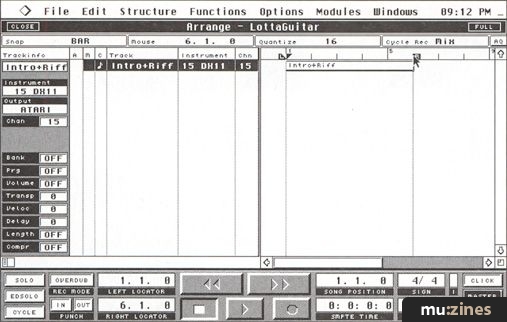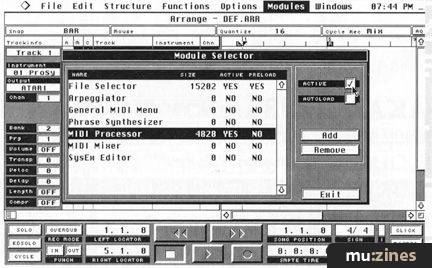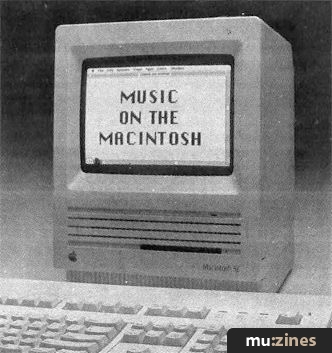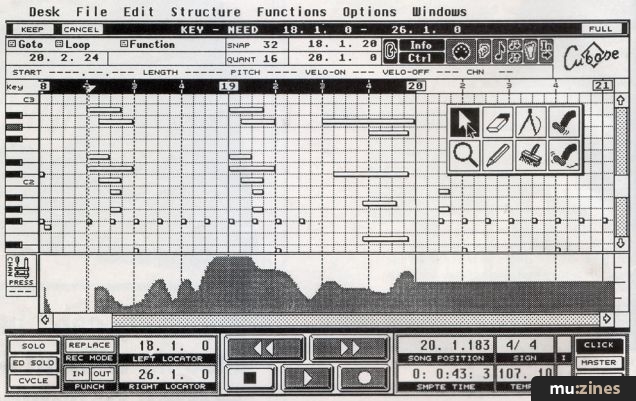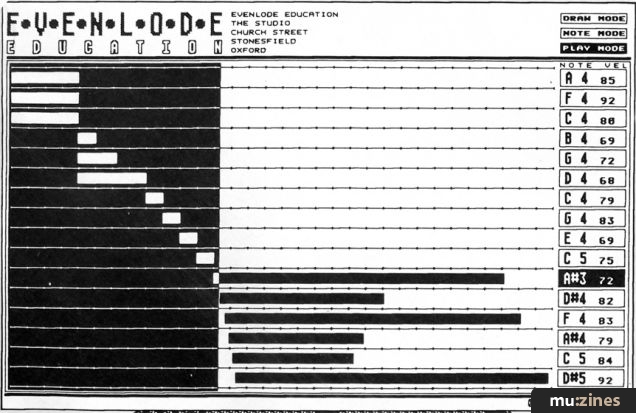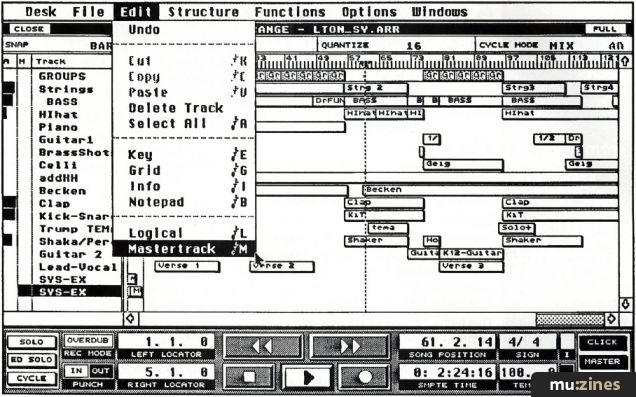Magazine Archive
Home -> Magazines -> Issues -> Articles in this issue -> View
Steinberg Cubase v1.5 | |
Software for the Atari STArticle from Music Technology, April 1990 | |
Meanwhile, at the other extreme of ST sequencing, Steinberg's Cubase program gains a real-time MIDI Manager and a large-format monitor. Nigel Lord touches a new base.
Only six months on from its release, the first update of Steinberg's Cubase sequencing package is with us - and the improvements are considerable.

ONE OF THE less auspicious aspects of shelling out on a dedicated sequencer in preference to one of the many software-based systems, is never knowing the pleasure of sifting through the post one morning and finding the disk and manual updates which effectively give your machine a new lease of life. Say what you like, but there's something rather gratifying about finding a system which you have grown familiar with suddenly become able to do other things - or the same things that much more easily.
Though this is not the place to enter a "hard versus soft' debate, I have to say I find the idea of a manufacturer putting time and effort into a system after you've parted with your cash, singularly attractive. All too often we're confronted with equipment that's come off the production line and (from an R&D point of view) been forgotten about.
So here we are, six months down the line and Cubase v1.5 is with us. Under normal circumstances, my first question would be, has it been worth the wait? But I doubt anyone's had enough time to exhaust the possibilities of v1.0 to the extent that they've been waiting for an update just yet.
I had a sneak preview of just what v1.5 would offer a few months ago, but such is the pace of development, the upgrade, when it actually appeared, included a host of features which weren't even mentioned at the time.
So what exactly does the upgrade bring? More importantly, for those still deciding whether to take the plunge or not, what extra features are there to attract you to Cubase? First and foremost has to be the Dynamic MIDI Management facility accessed via the Edit menu. This marvel of mind-over-MIDI could justifiably be described as a kind of MIDI "anything box'. Principally, it was designed to offer real-time control of MIDI accessible functions and parameters (outside those connected with the main sequencing process) for external equipment. In a sense it can be regarded as a new edit page, though to a limited extent, it duplicates certain functions which already exist within other pages of Cubase. Half an hour with the page on screen and a mouse in your hand, however, and you start to wonder how on earth you put up with the rather perfunctory control over MIDI offered by other systems.
The MIDI manager works at the level of individual Parts to which it assigns a selection of what Steinberg call Objects. An Object is simply an onscreen representation of a fader or pot, a numerical display or perhaps a switch, which may be called up at will (up to 128 of them) and sized and positioned anywhere on screen. The kind of MIDI information you wish each Object to send (anything from individual note data to SysEx events) is then defined and named, and the range in which it operates entered as minimum and maximum values.
The form each Object takes may be established by calling up a dialogue box. Here you can determine its appearance (ie. rotary or slider control, LCD or switch) and define its precise function. This latter process may be approached on one of two levels. Firstly, you can enter the data in hexadecimal using three sets of figures for the Status byte and two further data bytes (a Note On message, for example, would require a Note On status byte, Note Number and the velocity value). Alternatively, you can select the type of MIDI message you require from a couple of menus, and let Cubase sort out the rest. I have a feeling this latter option might prove more popular.
That said, if you do get off on hex numbers and status bytes, you're guided through the process quite carefully. Each set of figures, once entered, is interpreted as written information on the Info Line, and a dialogue box advises of any errors you may have made. Not only that, but all the information you're likely to need is contained in the rear sections of the instruction manual, and there are also conversion tables from hex to decimal and binary, should the manufacturer of the MIDI device you're using have opted for either of these formats in their documentation. I still prefer those menus...
If you don't know which controller or note number you want an Object to send, the MIDI Manager has a Learn function which will monitor the action of say, playing a key or turning a knob (providing this is transmittable as MIDI data) and commit it to memory. It works with Note, Controller and SysEx messages, though the MIDI channel number has to be entered by you.
As with other pages on Cubase, the MIDI Manager has its own set of tools. First of all there's a play tool (no sniggering, Jones minor), with which you rotate knobs, slide sliders or switch switches, a create tool for creating each object, an edit tool for modifying existing objects, and three different erase tools - all selected in the standard way using the right-hand mouse button.
"Cubase now supports a 19-inch monochrome monitor - you either view the usual screen contents in larger format, or include more information than a standard monitor."
Once set up, two types of MIDI Manager recording may be made. The first is of a "static mix" to initialise instruments and volume levels and so on - at the beginning of a song, for example. This can be done using Snapshots taken by clicking on (yes, you've guessed it) a Camera icon at the top of the screen. The second type of recording is of dynamic changes (hence the Dynamic MIDI Manager tag). Here, the moving of a fader or pressing of a switch during recording is faithfully re-enacted on playback. In practice, this means that even if you don't yet possess a MIDI mixing desk, automated mixdown is now possible (providing MIDI Volume is implemented on your external gear), and a rather tedious exercise like opening up the filter on a synth during a recording, for example, becomes simplicity itself.
There's a huge range of editing facilities connected with the MIDI Manager (including saving and loading of anything you've created), which I don't have the space to mention here, but in combination they provide the kind of control over MIDI data which though possible for some time now, has never been presented in such an accessible and attractive way.
When it was first released, the complexity and price of Cubase led a number of pundits to conclude that it was a program primarily designed for the professional studio user and would find few takers at the home studio end of the market. Whether this has proved true or not I'm not in a position to say, but I do know that an improvement featured in v1.5 is going to make it a more popular choice for the commercial studio owner. For the first time (to my knowledge, at least) an Atari sequencing package is now capable of supporting a 19-inch monochrome monitor - which you can configure either to display the usual screen contents in larger format, or to include more information than is normally present on a standard monitor. Whether you avail yourself of this facility depends somewhat on your readiness to shell out the £2,000 required for the cheapest 19-inch (hires) unit currently available.
A couple of rather more down-to-earth features come in the form of an Auto-save facility which may be set for any period between 2-30 minutes (and which saved my bacon during a lightning storm in early February) and a mouse accelerator or Speeder, as Steinberg refer to it. This latter function is rather different to the somewhat crude versions which "skip" a prescribed number of pixels as the mouse crosses the screen. The Speeder can be set to only operate above a predetermined threshold. In practice this means that you can charge about the screen like Nigel Mansell, but should you wish to do any fine editing (and users of Cubase's Key and Drum edit pages will know just how fine that editing can be), simply moving more slowly gives you back the degree of control possible with an unaccelerated mouse.
Speaking of mouse habits, in the same menu as the Auto-save and Speeder functions, there's also a facility for swapping the increment/decrement operation of the two mouse buttons. This, I would imagine will only appeal to those using Cubase for the first time (the left/down right/up habit being too hard to break for most people), but it's there if you need it. If, on the other hand, you're one of those people who prefer to input values straight from the keyboard, it's now possible to double click on practically every parameter and type in a figure directly.
MIDI delays (set in the Part Parameter box) are now displayed in milliseconds as well as ticks, and it's possible to copy a complete Track rather than having to do it Part-by-Part. Other functions, designed to make life that bit easier include: a global split function (which works across all tracks); an extended move and size function (which allows you to move and size a Part from within its Info dialog box), and the facility for building a Group Track in real time whilst the music is playing.
On the recording side, there's a new Multi Record mode which allows you to pass MIDI data on to any of four Outputs and MIDI channels, and it's now possible to record both Mute and Solo on/offs within the Arrange Window. If this sounds like a boon for those long arrangement sessions, it is. Just as impressive is Trigger Part function, which allows you to trigger a Part at any time in an arrangement by clicking on it using the magnifying glass from the tool box. Obviously your timing needs to be quite accurate, but I found this immensely useful in the short time I've been using it.
Not quite so useful - in fact somewhat annoying - is the addition of a small graphic symbol (a tiny drum stick) on any parts that have the Drum Map function activated. The idea, presumably is to make drum parts more easily identifiable within an arrangement, but because it cannot be overwritten, there's now not enough room on small parts for anything like a descriptive title - and that, as far as I'm concerned is far more important (especially as it can include the necessary indication of it being a drum-mapped part, if required).
The same thing is true of Parts associated with the MIDI Manager, only here we are confronted by two tiny faders rather than the drum stick. In this context it (perhaps) makes more sense, as we're dealing with a different type of data, but it still makes life difficult if you've cultivated the habit of giving your Parts a name (I won't tell you again, Jones minor).
"Let's put things in perspective: we're looking at a list of additions and improvements which necessitate the replacement or insertion of over 130 pages in the manual."
Back (apparently by popular demand), is the MIDI activity display which appeared on the main screen of Pro24, but was not included on v1.0 of Cubase. Here it takes the form of a column down the left-hand side rather than a row across the bottom, as it did on Pro24, but apart from that, is essentially the same. Speaking of which, it's now possible to convert Master Tracks recorded in Pro24 to enable Cubase to sync to tapes recorded using SMP24 or Timelock.
This, I'm sure will come as good news for those who came to Cubase via Pro24, as will details of the continuous increase in M.ROS compatible hardware, which, as of January 1990 includes (in addition to SMP24 and Timelock), MIDEX and MIDEX+, the Fostex R8/MTC1 and C-Lab Unitor.
On the software side, M.ROS can now support non-M.ROS programs whilst maintaining its multitasking capabilities. Thus we're offered the intriguing prospect of being able to run other sequencers at the same time as Cubase. Quite what the use for this would be I wouldn't care to speculate, but it sure as hell lends a whole new meaning to the expression 'side by side comparison'.
All four of the existing edit windows have been given extra features in the update, including extended Zoom facilities for Grid, Drum and Key Edit, and a new Explode function for Score edit which allows you to split the notes on the staff you're working on into several monophonic staves. To quote the example used in the manual update, this means you can now work independently on the four voices which comprise a chord progression and send them out on separate MIDI channels.
Also new in Score Edit is in Auto Quantise function designed to cope with situations where triplets and straight notes appear in the same piece of music (this also appears under the main Functions menu as Analytic Quantise), and there's also a new command which automatically moves the song to the current mouse position. Chord recognition in both Score and Key edit has been improved, though we aren't told how, and (I'm happy to say) Solo and Mute columns have been added in Drum edit. (Any chance of including the Pro24 feature which allowed you to input notes in real time from the computer keyboard in a future upgrade?)
In Grid Edit an extra Comment column has been added, and special events such as mute, stop and MIDI Manager have also been included. In addition, it's now possible to edit SysEx events in Grid edit, but they cannot be sent from here, you have to return to the Arrange window, I'm afraid.
Anything else? Well yes, actually, there are a couple of dozen other minor changes/improvements which I don't have room for - you'll have to check those out for yourselves.
Looking back on this review, it's hard to believe this is a software update we're talking about. Let's put things in perspective: we're looking at a list of additions/improvements which necessitate the replacement or insertion of over 130 pages in the manual.
The icing on the cake here is the MIDI Manager, and you can't help being struck by the thought that Steinberg could easily have released it as a piece of software in its own right - and charged £80-90 a time. That they haven't indicates their intention of keeping Cubase a force to be reckoned with, and in my opinion they've achieved this with room to spare.
(Contact Details)
Also featuring gear in this article
Clash of the Titans
(MIC Oct 89)
Cubase 2.0
(SOS Dec 90)
Cubase In-depth
(MIC Jan 90)
Cubase MIDI Mixer - Programming Clinic (Part 1)
(SOS Oct 92)
Cubase MIDI Mixer - Programming Clinic (Part 2)
(SOS Nov 92)
Dream Sequences (Part 1)
(MX Dec 94)
Dream sequences (Part 2)
(MX Jan 95)
Dream Sequences (Part 3)
(MX Feb 95)
Dream sequences (Part 4)
(MX Mar 95)
Dream sequences (Part 5)
(MX Apr 95)
Dream sequences (Part 6)
(MX May 95)
Dream sequences (Part 7)
(MX Jun 95)
Hands On: Steinberg Cubase
(SOS Jan 92)
Steinberg Cubase - Version 3.0 Software
(MT Sep 92)
Steinberg Cubase 3.0 (Part 1)
(SOS Apr 92)
Steinberg Cubase 3.0 (Part 2)
(SOS May 92)
Browse category: Software: Sequencer/DAW > Steinberg
Featuring related gear
An Old Pro - Steinberg Pro24 Amiga
(SOS Feb 91)
Macintosh or Atari?
(SOS Jan 88)
School's Out
(MIC Aug 89)
Software Tracking - Steinberg Pro24 Software
(EMM Sep 86)
Steinberg Cubase Audio
(SOS Nov 92)
Steinberg Cubase Lite - For the Atari ST
(MT May 93)
Steinberg Cubeat
(SOS Nov 90)
Steinberg Cubeat - Atari Sequencing Software
(MT May 91)
Steinberg Pro 24 - SoftwareCheck
(IM Oct 86)
Steinberg Pro24 Version III
(SOS Aug 88)

Steinberg Software Page
(SOS May 88)
Steinberg Software Page
(SOS Jun 88)
Yamaha Hello! Music! - computer music system
(MT Nov 93)
Browse category: Software: Sequencer/DAW > Steinberg
Publisher: Music Technology - Music Maker Publications (UK), Future Publishing.
The current copyright owner/s of this content may differ from the originally published copyright notice.
More details on copyright ownership...
Review by Nigel Lord
Help Support The Things You Love
mu:zines is the result of thousands of hours of effort, and will require many thousands more going forward to reach our goals of getting all this content online.
If you value this resource, you can support this project - it really helps!
Donations for November 2025
Issues donated this month: 0
New issues that have been donated or scanned for us this month.
Funds donated this month: £0.00
All donations and support are gratefully appreciated - thank you.
Magazines Needed - Can You Help?
Do you have any of these magazine issues?
If so, and you can donate, lend or scan them to help complete our archive, please get in touch via the Contribute page - thanks!
















